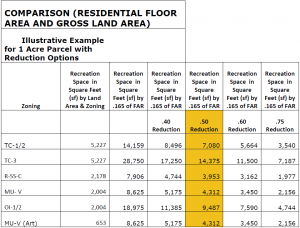I spoke before Council this evening on the proposed changes to Section 5.5 (Recreation) of the Town’s Land Use Management Ordinances (LUMO). The changes, which were discussed over a decade ago, approved by the NC Legislature July 10, 2008, essentially amount to an impact fee paid by developers to support parks and recreation.
To quote, the impact fee “could provide a new funding source for Parks and Recreation capital improvements in situations where payments are made in lieu of providing recreation space on site.”
Unlike other development fees, the Planning Board, Parks Commission and Town staff worked to hammer out an assessment that roughly tracked the number of new users of parks and recreation services these new developments add to the overall system. Given that, you would think that a high density development adding 5 times as many folks as a R5 zone development would pay more.
Crazily enough, that isn’t the case.
If you develop a high impact, high density development you can look forward to paying 1/2 what other developers pay and, as a bonus, get the rest of Chapel Hill’s residents to underwrite new recreation services on your behalf. Inequitable – but then again Chapel Hill’s residents have taken on burdens – including subsidizing the West140 development at $10+ million in cash and $15-25+ million in property – for other recent projects.
Since much of Town is built out and the number of low density residential opportunities shrink, the only strong near term revenue source will come from new high density developments. With a number of such new developments/redevelopments in the pipeline you would think staff and the advisory boards would urge Council to move fast – to strike while the iron is hot so to speak. The reality? A provision to delay while all these projects work themselves out of the pipeline.
Just doesn’t seem fair to either Chapel Hill’s existing taxpayers or folks developing less dense options.
From tonight’s staff memo [PDF]:
The following chart illustrates the effect of the proposed change for high density residential projects. The first column shows the required Recreation Space for a residential development using the current system. The second column shows the Recreation Space that would be required if the applicant develops the maximum allowable floor area under the proposed floor area based system, but without a reduction. The following columns show various reductions by percentage. The highlighted column is the recommended 50% reduction.

Here’s the remarks I made this evening (as usual – I edit on the fly so they reflect what I meant to say):
A few of you might recall that I have asked Council to provide a family friendly park, pocket parks along with other amenities Downtown these last 6 years. With that in mind, I’ve been following and commenting on the evolution of the proposed ordinance since it was first suggested. While the overall framework looks solid, tonight I’d like to highlight a glaring problem with that ordinance.
Higher density development Downtown has been promoted by calls for the need for more residents Downtown. More residents means more demand for high quality recreational opportunities.
The higher cost of development also applies to creating suitable recreational opportunities for these folks within or near their high density residences Downtown and elsewhere.
The proposed ratio of residential recreation space for TC1-3, RSSC, MUV and OI districts has been reduced – as the Parks Commission memo states – because “this provision may be necessary in order to encourage high density development in appropriate areas and to address the higher costs related to building high density development.” Note, no supporting material for that contention is given.
This ordinance has been in the pipeline since 2008 and the parameters for calculating much higher in lieu payments discussed since early this year. That hasn’t stopped proposals – like tonight’s Courtyard redevelopment project – from coming forward.
The proposed %50 reduction in the required ratio means that the burden of providing these facilities is shifted off the shoulders of the developers who are profiting from this type development squarely onto the rest of us residents in Chapel Hill.
As we’ve seen from the new crop of high density developments – East54 and Greenbridge, for instance – the community has invested significantly in infrastructure upgrades . These projects were granted substantial and beneficial variances above and beyond those allowed by the underlying zones. In one case a new zone – TC3 – was created to make the project work. In other words, we – the Chapel Hill community – have already supported this type of development with greater height limits, floor area ratios, reduced setbacks, reduced buffer, etc.
At least Greenbridge stepped up and accepted, as a condition of their SUP, a required payment to support the Hargraves Center.
Now the community is being asked to subsidize recreational opportunities for these high density developers who have already received the community’s largesse.
What do we know then? We know that there has been no evidence provided that supports the contention that having high density developers pay their fair share will impede the submission or approval of these type projects.
We know that reducing the required ratio will shift the cost of providing quality recreational opportunities onto the shoulders of the folks living outside these projects. This includes folks that have been waiting years, sometimes decades, for key unmet improvements they have already paid for with their taxes.
With projects like the University Square redevelopment, Courtyard and Obeys Creek, we know that delaying the implementation of this ordinance means with there is a good chance the best opportunities for developers to share the cost of providing public recreational facilities for the residents of their projects and nearby neighborhoods will be missed.
Please rethink the reductions in the high density requirements in light of the costs, the opportunities on the horizon and a common matter of fairness to the rest of Chapel Hill’s taxpaying public.